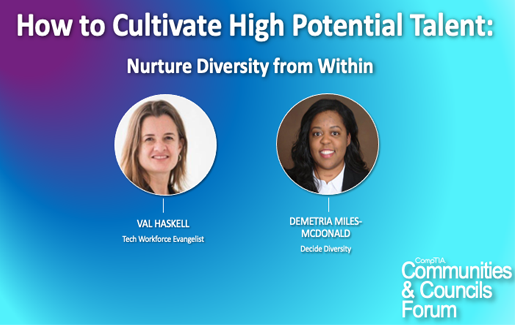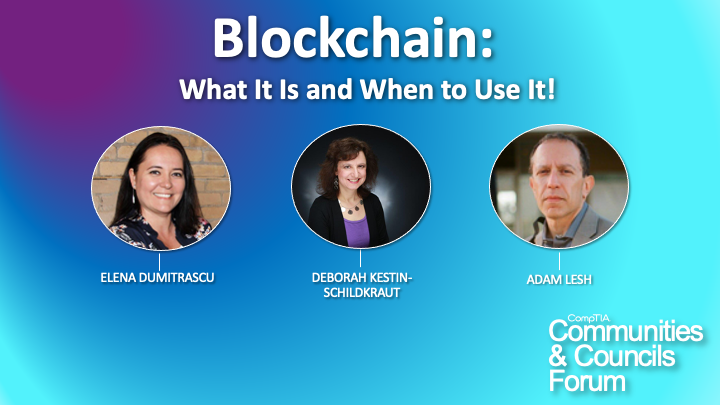 If you recognize and cultivate the employees you already have, you won't always need to compete for top talent from outside of your organization. But "one size" doesn't fit every employee, especially for companies that have recognized the vast benefits that come with diversity at all levels. At the virtual Communities and Councils Forum, Val Haskell, tech workforce evangelist and chair of the Advancing Tech Talent and Diversity Community at CompTIA, sat down with Demetria Miles-McDonald, founder and CEO of Decide Diversity, to discuss how to nurture existing talent while also focusing on diversity, equity and inclusion.
If you recognize and cultivate the employees you already have, you won't always need to compete for top talent from outside of your organization. But "one size" doesn't fit every employee, especially for companies that have recognized the vast benefits that come with diversity at all levels. At the virtual Communities and Councils Forum, Val Haskell, tech workforce evangelist and chair of the Advancing Tech Talent and Diversity Community at CompTIA, sat down with Demetria Miles-McDonald, founder and CEO of Decide Diversity, to discuss how to nurture existing talent while also focusing on diversity, equity and inclusion.
Diversify Leadership to Diversify High-Potential Employees
According to Miles-McDonald, organizations need to reconsider how they identify high-potential talent in a way that can contribute to DEI efforts. Traditionally, managers have used annual performance reviews to identify employees who go above and beyond, but that system tends favors employees who are similar to the managers conducting the reviews.
“We typically go by performance reviews when we're looking at high potential employees, but our biases really influence how we rate people,” said Miles-McDonald. “When you're looking at individuals that typically review really high, they're going to mirror the person who is doing their performance review… I absolutely believe that there are some opportunities for us to be better about how we identify high-potential employees.”
According to Miles-McDonald, diversifying management and leadership is a key component to ensuring that more employees have an opportunity to be identified.
“It's just like when you're hiring—if the slate is diverse, the potential of you hiring more diverse candidates increases. How can we diversify the leaders who are deciding on who are the high potential employees?” said Miles-McDonald.
Rethink the Annual Review
Reimagining the performance review process, particularly if your organization adheres to an annual review, is also critical. According to Miles-McDonald, once a year check-ins doesn't provide the whole picture.
“That’s very misleading as to who's going above and beyond. Who's showing commitment compared to others you know, who is better at communicating and who has an intense drive for developing themselves and, and continuous learning? If you're doing performance reviews on a more regular basis, like quarterly or even monthly, and it doesn't even have to be something that's super formal, then the chances of you identifying someone who is a high potential employee definitely increases," said Miles-McDonald.
Tell the Employee
Managers and leadership may identify high-potential employees without actually letting the employee know—and there’s likely some pros and cons to that decision. But, research does show that individuals who are formally identified as high potential do tend to live up to that label more so than those who aren't.
“It goes back to the self-fulfilling prophecy. So, the self-fulfilling prophecy is we've now identified you as a high-potential employee. And now you have that expectation that you're going to succeed,” said Miles-McDonald.
Challenge Your Talent with New Perspectives
Once you’ve identified an employee as high potential, how do you keep them? Retention is critical if you're going to reap the rewards of cultivating talent. Leaders must ensure that high-potential employees stay engaged, and having a diverse team is one way to do that.
“One thing I think a lot of organizations are not thinking about is the benefit of having diversity when it comes to high potential employees—they have someone there who's going to challenge them constantly,” said Miles-McDonald. “We often talk about when it comes to diverse perspectives at the table—being diverse is how we get to a solution that's greater and better than what any one of us individually could have come up with on our own.”
Provide Opportunities for Sponsorship
High-potential employees can’t reach that potential if they aren’t given a seat at the table. Sponsorship is the bridge that can give an employee the access and opportunities needed to be seen and heard by the right people. Miles-McDonald had her own sponsor early in her career that changed her trajectory, and now, it’s her turn.
“Now I'm the one who is making space for people to bring their ideas and thoughts to the table. And I don't always agree with all of them, but I believe that they have the ability to transform the organization. And oftentimes they just need the space to make that happen,” said Miles-McDonald.
Haskell agreed. “When you've had a very good sponsor, you see that that trajectory tends to change—it accelerates. It's one of the coolest, most rewarding parts about being a sponsor. Seeing that really take hold and seeing somebody launch like that.”
Nurture the Employees You Have
Being an employee in 2021 is very different than it was even two or three years ago. With rapid change has come a desire to be more open to employees "showing up" at work as their authentic selves. Intersectionality—the idea that people have more than one identity and those identities are interconnected—is gaining more acceptance in the workplace. And it’s critical if cultivating a culture of diversity, equity and inclusion is a priority.
“You have to be aware of when you're being inclusive of people because we show up as all of these things all the time. So when you're thinking about policies and programs to make people feel included, you have to look at it from an intersectional perspective. One of the things that's really interesting is when we look at the history of diversity, equity and inclusion, it's really put people into silos. One of the main reasons I got into this work is as I learned about diversity is that I couldn't show up fully to any one conversation... that's when I learned about intersectionality and it's a game changer,” said Miles-McDonald.
Join the Advancing Tech Talent and Diversity Community to network with peers and participate in initiatives to create more diverse, equitable and inclusive workplaces in the tech industry. .

 Add CompTIA to your favorite RSS reader
Add CompTIA to your favorite RSS reader

